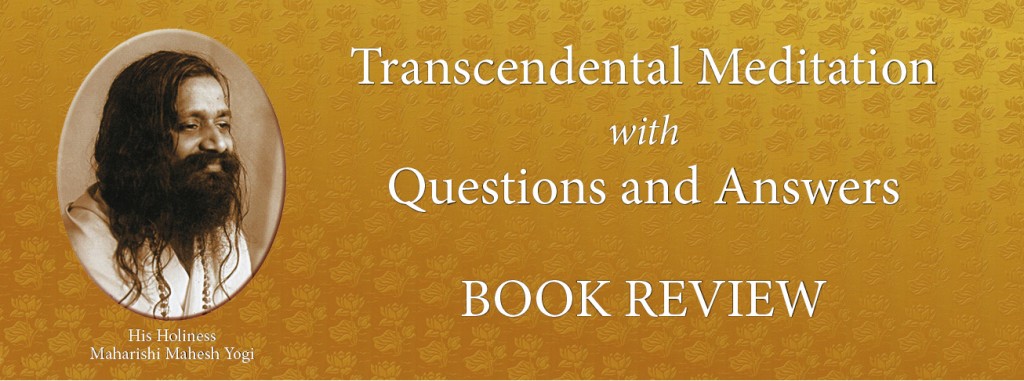Transcendental Meditation with Questions and Answers is an inspiring book that records in Maharishi’s own words the simple and yet profound message of enlightenment that he brought to the world. It was first published in 1967 by the International Spiritual Regeneration Movement at Maharishi’s Academy of Meditation in Rishikesh, Uttar Pradesh. Just 2,000 copies were printed at that time and so the present volume, printed in 2011 by Maharishi Foundation International, offers a precious insight into the early days of Maharishi’s teaching activities for us all to enjoy.
The book is in two parts: the first is the transcript of a lecture by Maharishi on Transcendental Meditation; the second consists of his answers to questions from audiences who attended his evening discourses given during the period March 1960 to mid-1961 while he was resident in London.
The lecture is typical of those that Maharishi gave as he travelled around the world, spreading his message that the nature of life is bliss. However familiar we may be with Maharishi’s teaching, we can only marvel at the depth of knowledge that he brings out, even as he spoke to people who were relative newcomers. Maharishi had recently arrived from India where, in 1957, he had inaugurated the Spiritual Regeneration Movement with the goal of spiritually regenerating the world. Many of those who came to listen to him when he embarked on his travels were seekers of enlightenment. Therefore it was natural that he spoke in terms of realisation of the Divine and emphasised the power of Transcendental Meditation to harmonise the inner spiritual value of life with outer material values.
“The word ‘meditation’ is not new; nor are the benefits of meditation new,” he said in the lecture. “On the contrary, the message is centuries-old: it is the message of Buddha, of Christ and of Krishna. It says, as they said, only get to the inner kingdom, to the heavenly heart, and you will earn for yourself eternal freedom – not in the future, not after death, but now and forever.”
Maharishi continued the lecture by developing his theme that the ultimate reality of life is absolute Bliss Consciousness – the one reality that underlies all subjective and objective aspects of life. He discusses the nature of the soul as pure transcendental Being and the pathless path to Self-realisation, for, as he explains, “the realisation of the Self is only the realisation of one’s own Being, which is at no distance from oneself and is always available”.
Yet, he goes on to ask, “If absolute Bliss consciousness is universal and omnipresent, how can it be that we do not feel it?” In his answer to this apparent paradox Maharishi discusses the reason for suffering and explains that the cure lies in practising Transcendental Meditation. It provides an effortless way to directly experience pure Being – “that which is described as the Kingdom of Heaven, or Sat-chid-ananda, the absolute Bliss Consciousness”.
Then follows a fascinating discussion of different approaches to realisation of the Divine: the way of the Sanyasi, or recluse, who uses the power of discrimination to distinguish between the impermanence of the world and the permanence of the Divine; and, the way of maintaining Self-awareness through intellectual discipline. Unfortunately, as Maharishi points out, this latter divides the mind and can merely lead to an illusion of higher consciousness. “It is playing with the idea of the Divine,” he says, “but it is not the attainment of the reality of the Divine, which is the state of Transcendental Being and Pure Consciousness.” What is needed is the direct experience of this state.
Using passages from the Upanishads and the Yoga Sutras of Patanjali, Maharishi then shows how Transcendental Meditation uses the bliss-attribute of the Absolute to effortlessly lead us to experience it within: “It is only necessary to turn the mind inwards,” he says, “towards the light of bliss-happiness, and the mind will flow towards it as water flows downhill.”
Maharishi concludes his lecture with a detailed discussion of how the practice of Transcendental Meditation leads to the development of higher consciousness – the state of union with the universal Cosmic Mind that is known to all religions: the Kingdom of Heaven to Christians, Nirvana to Buddhists, and Atmananda in the language of the Vedic Literature. He explains how Transcendental Consciousness is the source of all creativity. The creative energy of which it is composed can be brought out to enrich all aspects of life, with universal benefits for all areas of society. The ultimate goal, he says, is the attainment of Cosmic Consciousness, which he defines as “the highest peak of human evolution, the state in which man, the human, is transformed into Man, the Divine …” He finishes with words of inspiration for us all: “the process of attainment is not difficult, nor laborious, nor demanding of suffering; it is simple, sure, and, above all, natural.”
The question and answer section that follows forms the larger part of the book and covers a wide range of topics: the experience of Transcendental Consciousness, the value of the mantra, God realisation, faith and religion, free will, the relationship of the mind and body, karma (or cause and effect) and Transcendental Meditation as a means of liberation from the binding influence of karma, the question of why there is suffering when the nature of life is bliss, and the role of an Enlightened Master.
Finally, a short appendix at the end of the book summarises Maharishi’s achievements, from 1957 when he inaugurated the Spiritual Regeneration Movement to January 2008 when he inaugurated the Year of Invincibility – Global Raam Raj – celebrating the success of 50 years of his worldwide Movement. As the authors note, it is an achievement that continues to unfold year after year “as the evolving trends of time bring forth the full sunshine of Heaven on Earth – Raam Raj”.
Transcendental Meditation with Questions and Answers is available from Maharishi Ayurveda Products.
Reproduction of an original article from Transcendental Meditation News.






